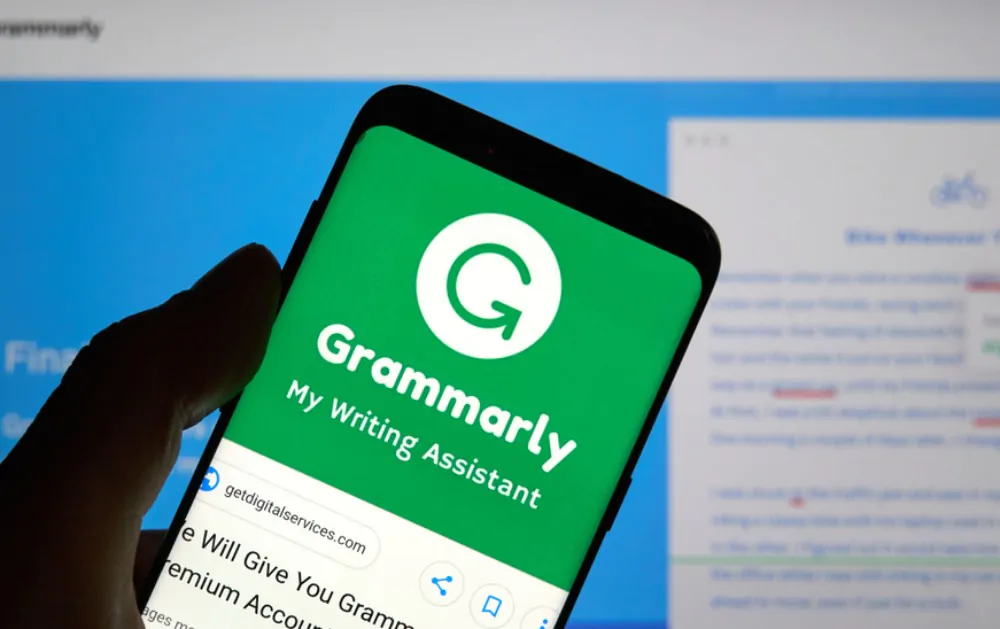There are numerous opportunities for copywriters. If you are considering it, you may wonder, ‘Is copywriting hard?’ Read on to see if it’s a good fit for you.
Is copywriting hard? Not if you can figure out what your customers want, use language they understand, and articulate your product or service in terms of benefits, not features.
Whether you’re a freelance copywriter, a full-time copywriter, or a business owner, learning the basics doesn’t require dozens of hours or lots of resources. It’s more about your process.
According to Statista, 51.75% of people seeking writing jobs want to learn more about copywriting. But, those new to the field are often confused because copywriting lacks a defined career path, and it’s not something you can learn in university or college.
I worked as a freelance copywriter for several years before working in-house within the SaaS industry. I also worked as a freelance technology copywriter. I spent my days writing emails, scripts for webinars, landing pages, social media posts, and even assets for content marketing campaigns.
In this article, I share nine key lessons from my copywriting career. And when you have digested them, take a look at my recommendations for the best copywriting books.
Contents
- 1. Marry Copy with Design
- 2. Use Language Your Customer Understands
- 3. Sell Using Customer Testimonials
- 4. Sell with Benefits, Not Features
- 6. Keep a Swipe File of Copy That Converts
- 7. Use AI Copywriting Tools
- 8. Build Your Copywriting Business
- 9. Refine Your Skill Set
- What is the Hardest Part About Being a Copywriter?
1. Marry Copy with Design
A good copywriter knows words and imagery go hand-in-hand. Apple does a great job of marrying compelling product imagery of the latest iPhone or MacBook with easy-to-read copy. They apply principles top copywriter Leo Burnett articulated long ago. He said:
“Make it simple. Make it memorable. Make it inviting to look at. Make it fun to read.”
If you want to make it simple, remove complicated words and phrases.
If you want to make your copy memorable, use personal stories.
If you want to make your copy inviting to look at, marry design with copy.
If you want to publish copy that’s fun to read, use persuasive emotional language. (Power words are great for this).
2. Use Language Your Customer Understands

Beginners and new copywriters fall into the trap of using complicated language to demonstrate expertise. Here’s a friendly reminder from top copywriter Eugene Schwartz:
“There is your audience. There is the language. There are the words that they use.”
As a copywriter, forget about a literary or flowery writing style. Your only job is to sell for your clients or employer! I worked as a copywriter for a few years for a SaaS company. Often, the product managers wanted to explain the products’ technical features at length on the sales pages. However, concise and easy-to-read copy generated more sales than length and technical jargon.
Business owners often make the same mistake. Excited about their product or service, they forget that prospects are pressed for time and attention. Write in plain English, ensuring your copy is memorable and easy to read. The Hemingway App is a valuable tool for simplifying complicated copy.
3. Sell Using Customer Testimonials
Acquiring and using customer testimonials is key for any copywriter wanting to increase client conversion. Top copywriter Robert Collier dropped this bombshell back in the early 1900s:
We have become so accustomed to hearing everyone claim that his product is the best in the world, or the cheapest, that we take all such statements with a grain of salt.”
What would Collier and other great copywriters think of the wild claims on social media platforms like X or LinkedIn? If you want to state a bold claim about your product or service, find a customer who’ll do it for you. Give away a free version to 5 or 10 ideal customers. Ask them to provide a testimonial that you can use on your sales page.
Text is good, video is better. VideoAsk, StoryPrompt, and Bonjoro all provide tools for these asks. It’s easier to state big claims alongside product descriptions if a happy customer or client does it for you!
4. Sell with Benefits, Not Features
New copywriters often get excited about what a product can do, but here’s why customers really buy… according to Joanna Wiebe of Copyhackers:
“Here’s the only thing you’re selling, no matter what business you’re in and what you ship: you’re selling your prospects a better version of themselves.”
While there’s a place for articulating how a product works, it’s more effective to article these features in terms of benefits using everyday language.
Sure, features are clever, but that’s not why people buy. Instead, turn those features into benefits. Explain how the product or service will help the ideal customer achieve a big transformation. For example, a pencil is a wooden cylinder surrounded by a graphite core, capped with an erasure (feature). But you can use it to express yourself quickly and easily (benefit).
5. Learn What Keeps Your Customer Up at Night
A good copywriter knows what their target audience or prospects want. Avoid complicating things for yourself by inventing an entirely new market or category. Your target audience already knows what it wants, so write about that. Or as Eugene Schwartz, author of Scientific Advertising, wrote:
“Tap a single overwhelming desire existing in the hearts of thousands of people actively seeking to satisfy it at this very moment.”
To figure out what customers want, survey them. Ask questions like, “What’s your biggest frustration with X?” or “What’s the one thing you’d really like to achieve with X?”
You can also use SEO tools like Exploding Topics or Answer the Public to find trends and popular questions in your niche or industry. Then, when writing copy, answer your prospect’s questions and concerns on the landing page or web copy.
6. Keep a Swipe File of Copy That Converts
Successful copywriters study what already works and use that. Copywriter Gary Halbert wrote to his son (an aspiring copywriter), “Get yourself a collection of good ads and DM pieces and read them aloud and copy them in your own handwriting.”
A successful copywriter keeps a swipe file of converting sales pages and email funnels they can refer to. If you’re a freelance copywriter, consider creating a dedicated email account for your niche or industry. Use this to sign up for email marketing campaigns and sales funnels. Studying copy that converts will dramatically improve your copywriting skills. Similarly, taking screenshots or clippings of landing pages and marketing materials from successful campaigns is a good idea.
Pay special attention to their claims and big promises. Take note of how they articulate a product’s features regarding benefits. We interviewed copywriter Geoff Kullman on our podcast, who elaborated on this idea. If you need some inspiration, check out Swipe File. It contains hundreds of examples of successful ads, digital marketing, and traditional marketing campaigns.
7. Use AI Copywriting Tools

AI and related tools are changing how copywriters work today. These days, copywriters have a plethora of tools to pick from. Hotjar and Clarity are useful for creating heatmaps of landing and sales pages and figuring out what to improve next.
Jasper AI contains time-saving templates for copywriters struggling to figure out a structure for their sales pages.
Tools like Wordtune can help copywriters expand, condense, or write their copy. It’s a neat and affordable paraphrasing tool. Read our Wordtune review.
ChatGPT can help copywriters turn a feature into a benefit with a prompt like, “Hey ChatGPT, take this product feature and turn it into a benefit using everyday language my customer understands.”
Grammarly is also great for editing and revising copy—bonus points for using GrammarlyGo inside your writing app. Read our ChatGPT vs Grammarly comparison.
Answer the Public is great for discovering your prospects’ questions. These AI tools won’t do the hard work of selling a product or service, but they can provide time-saving templates and first drafts that any business owner or freelance copywriter can edit or work with. Any professional copywriter who wants to hone their skill set should consider AI as part of their toolbox.
8. Build Your Copywriting Business
Many copywriters work freelance or for themselves. If so, treat it like a business. Like many freelance writers, you may need to work for a few clients at a bargain or discount till you acquire the writing skills. Don’t do this for long. Specialize in one niche and scale your rates. Spend a few hours each week or month pitching potential clients and looking for other gigs. Platforms like UpWork can help with this.
At the end of a job, get a testimonial from the client or company you worked with and put this on your copywriting website or landing page. And ask for referrals.
You’ll also have to consider secondary skills like managing your books.
The alternative is to find a copywriting job in-house working for a company. However, you must still develop your skills quickly and be competent at time management to adhere to deadlines.
For more tips, read our guide explaining how to become a copywriter.
9. Refine Your Skill Set
Independent learning is a key skill for copywriters. It’s an unusual career because there are few traditional high school, college, or university courses in this writing field.
Many copywriters have degrees or training in English, marketing, advertising, communications, or a related discipline. Even then, copywriting doesn’t have a defined career path.
Regardless of your background, you must be prepared to teach yourself. Learning copywriting means reading copywriting books, taking online courses, and studying related disciplines like SEO and content marketing.
For example, understanding the basics of SEO helps if you want landing pages and web pages to rank in search engines. Similarly, learning the role of content marketing within a business will help you figure out what constitutes a successful campaign. Acquiring related skills also means you can charge clients more.
What is the Hardest Part About Being a Copywriter?

The hardest part about being a copywriter is finding paying writing work if you’re a freelancer. If you’re working in-house, the hardest part is managing feedback from multiple stakeholders about your copy, which is often wrong or conflicting.
To solve the former problem, pitch for new gigs or potential clients regularly. To solve the latter, use data and analytics to articulate what copy is converting or not converting.
Copywriting is a rewarding and profitable career. I only stopped working as a copywriter because I wanted to grow my content publishing business. However, I still occasionally work with clients as a copywriter.
If you’re going to break into copywriting, acquire the right skills. Pick a niche that you want to work in. And learn from others who are further along in their copywriting career. Decide if you want to work freelance or in-house. You may have to work or learn independently to succeed, but it’s worth it. The skills you’ll learn along the way are easily transferable to other types of writing work, including content marketing, blogging, and writing online.